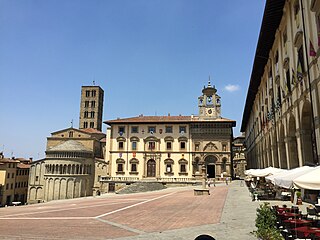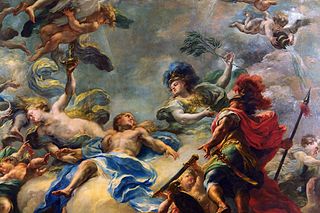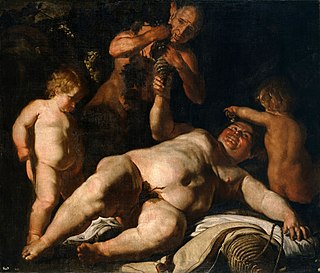
Masaccio, born Tommaso di Ser Giovanni di Simone, was a Florentine artist who is regarded as the first great Italian painter of the Quattrocento period of the Italian Renaissance. According to Vasari, Masaccio was the best painter of his generation because of his skill at imitating nature, recreating lifelike figures and movements as well as a convincing sense of three-dimensionality. He employed nudes and foreshortenings in his figures. This had seldom been done before him.

Arezzo is a city and comune in Italy and the capital of the province of the same name located in Tuscany. Arezzo is about 80 kilometres southeast of Florence at an elevation of 296 metres (971 ft) above sea level. It is also 30 km west of Città di Castello. In 2013 the population was about 99,000.
![Luca Signorelli [[Italian Renaissance]] [[Painting|painter]]](https://upload.wikimedia.org/wikipedia/commons/thumb/2/20/Signorelli%2C_Luca_-_selfportrait_alone.jpg/232px-Signorelli%2C_Luca_-_selfportrait_alone.jpg)
Luca Signorelli was an Italian Renaissance painter who was noted in particular for his ability as a draftsman and his use of foreshortening. His massive frescoes of the Last Judgment (1499–1503) in Orvieto Cathedral are considered his masterpiece.

Pellegrino Tibaldi, also known as Pellegrino di Tibaldo de Pellegrini, was an Italian mannerist architect, sculptor, and mural painter.

Cosimo Rosselli (1439–1507) was an Italian painter of the Quattrocento, active mainly in his birthplace of Florence, but also Lucca earlier in his career, and from 1480 in the Sistine Chapel in Rome, where he painted some of the large fresco panels on the side walls. Despite being roughly the same age as Sandro Botticelli, Pietro Perugino and Domenico Ghirlandaio, the other leading Florentine painters, all regarded as greater talents, Rosselli was still able to win several large commissions, which is a testament to the high level of activity in the city.

Benedetto da Maiano was an Italian sculptor of the early Renaissance.
Giovanni Balducci, called Il Cosci after his maternal uncle, was an Italian mannerist painter.

Ortolano was an Italian painter of the Ferrara School, active in the Renaissance period. Ticozzi cites his birth as ca. 1480.

Santa Caterina a Formiello is a church in Naples, in southern Italy, located at the extreme eastern end of the old historic center of the city, on Via Carbonara and Piazza Enrico de Nicola, near the gate called Porta Capuana. The term Formiello comes from the forms or containers for water spouts found in the convent. Diagonally across the street and South is the Fontana del Formiello against the rear wall of the imposing Castel Capuano.

Marcello Venusti was an Italian Mannerist painter active in Rome in the mid-16th century.

Guido Tarlati was a lord and Bishop of Arezzo.
Francesco Ruviali was an Italian painter of the Renaissance period.

Giacomo del Pò, also spelled del Po, was an Italian painter of the Baroque. He was born in Palermo, the son of Pietro del Pò who was also his teacher.
Orazio Frezza was an Italian painter of the Baroque period, born and active in Naples,
Tommaso degli Stefani (1231–1310) was an Italian artist, working in Naples.

Dono Doni, also known as Adone Doni or Dono dei Doni (1505-1575) was an Italian painter of the Renaissance period active mainly in Umbria.

Castel Sant'Elmo is a medieval fortress located on a hilltop near the Certosa di San Martino, overlooking Naples, Italy. The name "Sant'Elmo" derives from a former 10th-century church, Sant'Erasmo, shortened to "Ermo" and, finally altered to "Elmo". It presently serves as a museum, exhibition hall, and offices.

Cesare Fracanzano (1605-1651), a Neapolitan painter who flourished in the 17th century, was a pupil of Spagnoletto. Born in Bisceglie, in Apulia by Alessandro, a nobleman originally from Verona and a mannerist painter. His pictorial style was based on Ribera, but also on Tintoretto, the Carracci brothers and Guido Reni. After long years of artistic preparation and work in Naples, in 1626 he returned to Apulia, to Barletta where he married Beatrice Covelli. He worked a lot in the Apulian town in churches and noble palaces. He moved from his hometown only to carry out work commitments in Naples, Rome and other places in Apulia. There is in the Museo del Prado (Madrid) a picture by him, representing Two Wrestlers. His son, Michelangelo Fracanzano, who was also a painter, died in France about 1685. His brother Francesco was also a painter.
The public domain consists of all the creative work to which no exclusive intellectual property rights apply. Those rights may have expired, been forfeited, expressly waived, or may be inapplicable.

Michael Bryan was an English art historian, art dealer and connoisseur. He was involved in the purchase and resale of the great French Orleans Collection of art, selling it on to a British syndicate, and owned a fashionable art gallery in Savile Row, London. His book, Biographical and Critical Dictionary of Painters and Engravers, first published in 1813-16, was a standard reference work throughout the 19th century, and was last republished in 1920; however it is now badly outdated.






![Luca Signorelli [[Italian Renaissance]] [[Painting|painter]]](https://upload.wikimedia.org/wikipedia/commons/thumb/2/20/Signorelli%2C_Luca_-_selfportrait_alone.jpg/232px-Signorelli%2C_Luca_-_selfportrait_alone.jpg)











